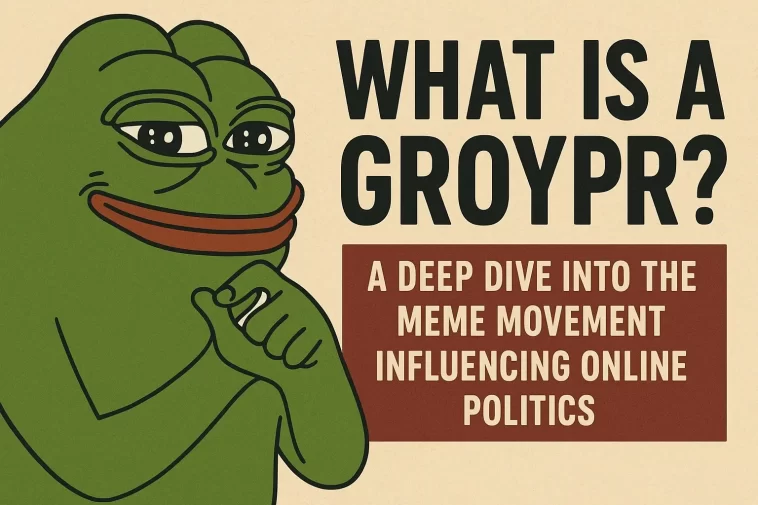Over the past few years, the term “Groyper” has shifted from being just another obscure internet meme into a widely debated cultural and political phenomenon. The image of a cartoonish frog resting its chin on its hands has evolved into more than a meme: it has become the face of a movement that thrives on challenging mainstream narratives. But what is a Groyper really, and why does this concept matter in today’s online political discourse?
This article explores the origins, ideology, controversies, and cultural significance of the Groyper phenomenon, offering a comprehensive perspective for those seeking to understand this increasingly relevant online subculture.
The Origins of the Groyper Meme
The Groyper meme began as a visual cousin of Pepe the Frog, one of the internet’s most famous cultural symbols. While Pepe was widely adopted across various communities — from harmless internet jokes to darker political memes — the Groyper character emerged with a more specific identity.
The classic Groyper image depicts a chubby frog leaning forward with folded hands, often interpreted as smug or contemplative. Over time, this simple image became the emblem of a movement that wanted to distinguish itself from mainstream conservatism.
From Meme to Movement: The Rise of the “Groyper Army”
By the late 2010s, the Groyper Army began gaining visibility online, particularly within right-wing spaces on Twitter, YouTube, and various forums. Unlike casual meme-sharing communities, Groypers defined themselves around a mission: questioning mainstream conservative leaders and institutions.
A defining moment came when young Groypers started attending campus events and conservative gatherings, asking sharp, controversial questions to speakers aligned with mainstream conservative organizations such as Turning Point USA (TPUSA). These confrontations were often recorded and shared online, amplifying the Groyper presence and narrative.
Supporters claimed they were holding conservative leaders accountable for failing to address sensitive issues such as immigration, foreign policy, and cultural identity. Critics, on the other hand, argued that Groypers were injecting extremist rhetoric into public discourse.
Leadership and Key Figures
While Groypers present themselves as a decentralized movement, one figure has become closely tied to its growth: Nick Fuentes, a political commentator and online personality. Fuentes and his followers promoted a brand of conservatism they believed was more authentic, rejecting what they viewed as watered-down or establishment-friendly policies.
Other influencers and online figures have also been linked to the movement, though many distance themselves from the Groyper label due to its increasingly controversial associations.
The Groyper Ideology
At its core, the Groyper movement is less about policy details and more about cultural positioning. Their ideology often includes:
- Nationalism and Traditionalism: Advocating for stronger borders, traditional family values, and skepticism toward globalization.
- Criticism of Mainstream Conservatism: Groypers accuse established conservative organizations of compromising too much with liberal culture.
- Christian Identity: Many Groypers emphasize Christianity as a central part of their worldview.
- Online Provocation: Using memes, confrontational questioning, and viral tactics to spread their message.
This combination of ideology and strategy has made Groypers both influential and divisive within broader political discussions.
Criticism and Controversies
The Groyper movement has been heavily criticized for promoting exclusionary, inflammatory, and sometimes extremist rhetoric. Universities and event organizers have faced challenges when Groypers appeared at public gatherings. Critics argue that their tactics often cross the line from debate into harassment.
Mainstream conservative groups like TPUSA have publicly clashed with Groypers, distancing themselves from what they describe as a fringe movement. Meanwhile, left-leaning commentators argue that Groypers represent the dangerous mainstreaming of alt-right ideologies through meme culture.
Media Coverage and Public Perception
Media coverage of Groypers varies significantly depending on the outlet. Mainstream news organizations typically portray them as part of an extremist online movement, while alternative media outlets sometimes frame Groypers as young conservatives dissatisfied with the status quo.
This contrast in coverage reflects the broader challenge of understanding online subcultures: what begins as a meme can quickly develop into a political identity with real-world consequences.
Why Groypers Matter in Today’s Digital Landscape
The rise of Groypers illustrates how memes and online humor can transform into vehicles for ideology. In an era where politics and internet culture are deeply intertwined, movements like the Groyper Army highlight several important dynamics:
- Generational Divide: Younger conservatives often feel disconnected from established institutions and look for new ways to express their political identity.
- Digital Mobilization: Online platforms give relatively small groups outsized influence through viral content.
- Culture Wars: Groypers thrive in debates about identity, religion, immigration, and free speech.
- Meme Power: Internet humor isn’t just entertainment—it can be a powerful tool for recruitment and influence.
Academic Perspectives on Meme Movements
Scholars studying internet culture have pointed out that memes function as modern political pamphlets, carrying ideas in digestible, humorous formats. While a traditional political pamphlet might outline ideology directly, memes like the Groyper image spread through subtle cues, humor, and shared identity.
This makes Groypers a textbook example of how digital natives — particularly Gen Z and younger millennials — engage with politics differently than previous generations.
Conclusion: The Future of the Groyper Identity
So, what is a Groyper? The answer lies somewhere between internet humor and political activism. For some, it is a funny frog meme. For others, it is a rallying symbol for cultural and ideological battles.
What cannot be denied is the influence of the movement. As memes continue to shape political discourse, the Groyper phenomenon underscores how online communities can mobilize, challenge authority, and redefine political narratives.
Whether viewed as dangerous extremists or rebellious truth-seekers, Groypers embody the power of digital culture in shaping real-world debates.

